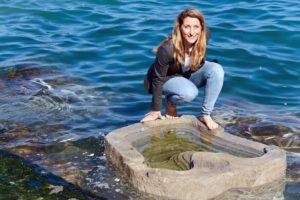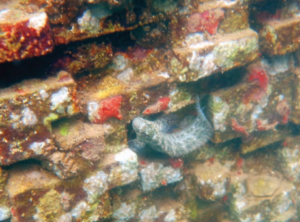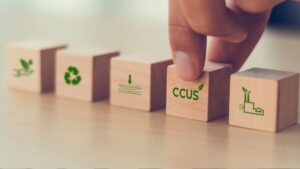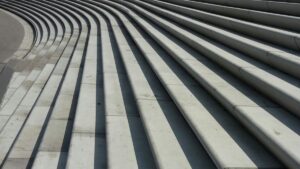Innovating for Resilience: Announcing ECOncrete’s Dr. Shimrit Perkol-Finkel as Cleantech Interactive Speaker
With half of the world’s population concentrated along coastlines, we now find ourselves in need of extraordinary solutions to combat the combined threats of rising sea levels, increasingly harsh storms and environmental damage inflicted by coastal development.
We are thrilled to announce that Dr. Shimrit Perkol-Finkel, co-founder and CEO of ECOncrete, will join us at Cleantech Interactive, our virtual event on May 19-20. Ahead of the event, we spoke with Shimrit to learn more about ECOncrete.
What’s the story behind ECOncrete?

My co-founder and I are both marine biologists and have seen first hand the extent of the environmental damage that human activity is creating along coastlines.
We thought it just doesn’t make sense to continue building structures that don’t take the local ecology into account. Our challenge? Find a solution for coastal development that could sustain and even enhance marine environments.
We realized that about 70% of coastal structures globally are made of concrete. Diving in ports and marinas, concrete is everywhere. However, concrete does not provide a healthy substrate for marine life. In fact, concrete seawalls hinder biodiversity development and are not good surrogates to coral reefs.
So, we started to tweak the material, getting inspiration from the field of artificial reefs. What if we used concrete but tuned it in a way that facilitated the colonization of marine life? And what if, at the same time, we could improve its strength to resist extreme weather events?
How did you come up with your solution?
We started with testing about 20 different concrete mixes. We learned about additives, what makes them harmful for marine life and how we could reduce this detrimental effect. After two years of research and development, we were able to create a mix of materials that could replace 10% of the regular cement and increase the concrete’s marine life colonization success rates from 5-10% to 60-70%.
In addition to fine-tuning this bio-enhancing material, we also used surface roughness and 3D design to maximize ecological success and resistance to extreme weather events.These early successes led us to develop the product and expand the company.

What is the economic case for bio-enhancing concrete?
The construction industry operates with very low margins and our solutions cost 5-10% more than traditional ones. So, the economic case for using our product comes from a combination of regulatory requirements and disaster risk reduction.
Some countries are putting increased pressure on coastal developers to mitigate (or compensate) their environmental impact. In the United States, for instance, for each acre of planned costal development in New York or California, the developer must pay $1- $1.5 million to a compensation scheme. The United Kingdom, France and the Netherlands are moving in the same direction. Our solution can decrease that payment by up to 70%, as regulators recognize the positive environmental impact of our solution, notably that the biology that develops in our structure can assimilate CO2. It can also make the permitting easier. That can make a big difference and justify our extra cost.
Following extreme weather events, local authorities are keen to find solutions that can protect coastal communities. That is another driver helping us promote our solution.
How fast are regulation and coastal construction standards evolving?
It takes a long time for things to change in the construction industry and in the first few years, potential clients had a tendency to cross off anything new.
When our EcoPowder, the core of our technology, passed EU, UK, and Australian standards as a workability improvement agent, it provided a short-cut. Longer-term, our vision is to create a standard for bio-enhancing concrete, but I can imagine it taking 5-10 years.
At the same time, ports are increasingly building structures to integrate new technologies, with incubators, accelerators and even VC arms. So, this is an additional incentive for them to integrate new technology, such as ours, into their operations.
Can you tell us about a project you’re excited about?
In 2012, following the aftermath of Hurricane Sandy, ECOncrete product designs were integrated in a unique project in New York that combined risk reduction with ecological restoration. Ours was one of six winning projects in the U.S. Department of Housing and Urban Development (HUD)-sponsored Rebuild by Design competition, aimed to redesign the coastline and make it both more resilient to extreme weather events as well as more environmentally-friendly.
The project includes a necklace of breakwaters that will serve to protect the coast from future superstorms as well as restore local marine communities, mainly oysters, that used to protect those coastlines naturally. The environmental benefits of the ecological design significantly lower the project’s need for offsetting.
We are looking to replicate these concepts on the West Coast, where the threat of rising sea levels is acute. We are currently working with the Port of San Diego on a unique COASTALOCK product tailored to the port’s structural needs while generating a unique field of tide pool habitats.
What is your typical business model for these projects?
Until a couple of years ago, we relied mostly on direct sales, with products being sold directly to clients. We would subcontract local manufacturers to avoid shipping blocks of concrete. Two years ago, we started working with approved manufacturers and distributors and are starting to go down the licensing route.
What are your ambitions for the next 3-5 years?
Now that we have gone through extensive R&D and have closed large initial sales, we are focusing on scaling up our production capacity to capitalize on recent growth.
We also hope to work with global institutions, like the World Bank, to deploy solutions to developing countries where healthier and better protected coastlines are a matter of urgency. Unsustainable methods of fishing, aquaculture and mangrove destruction have upset the balance of ecosystems and reduced their productivity. In some countries, I have seen entire reefs destroyed by blast fishing. If we can integrate ECOncrete in projects in ports and coastal cities, we can help bring back some biodiversity and do our part to restore vital ecological processes.


